Abstract
Acanthamoeba castellanii myosins IA and IB demonstrate the catalytic properties of a myosin and can support analogues of contractile and motile activity in vitro, but their single, low molecular weight heavy chains, roughly globular shapes, and inabilities to self-assemble into filaments make them structurally atypical myosins. We now present the complete amino acid sequence of the 128-kDa myosin IB heavy chain, which we deduced from the nucleotide sequence of the gene and which reveals that the polypeptide is a fusion of myosin-like and non-myosin-like sequences. Specifically, the amino-terminal approximately 76 kDa of amino acid sequence is highly similar to the globular head sequences of conventional myosins. By contrast, the remaining approximately 51 kDa of sequence shows no similarity to any portion of conventional myosin sequences, contains regions that are rich in glycine, proline, and alanine residues, and lacks the distinctive sequence characteristics of an alpha-helical, coiled-coil structure. We conclude, therefore, that the protein is composed of a myosin globular head fused not to the typical coiled-coil rod-like myosin tail structure but rather to an unusual carboxyl-terminal domain. These results support the conclusion that filamentous myosin is not required for force generation and provide a further perspective on the structural requirements for myosin function. Finally, we find a striking conservation of intron/exon structure between this gene and a vertebrate muscle myosin gene. We discuss this observation in relation to the evolutionary origin of the myosin IB gene and the antiquity of myosin gene intron/exon structure.
Full text
PDF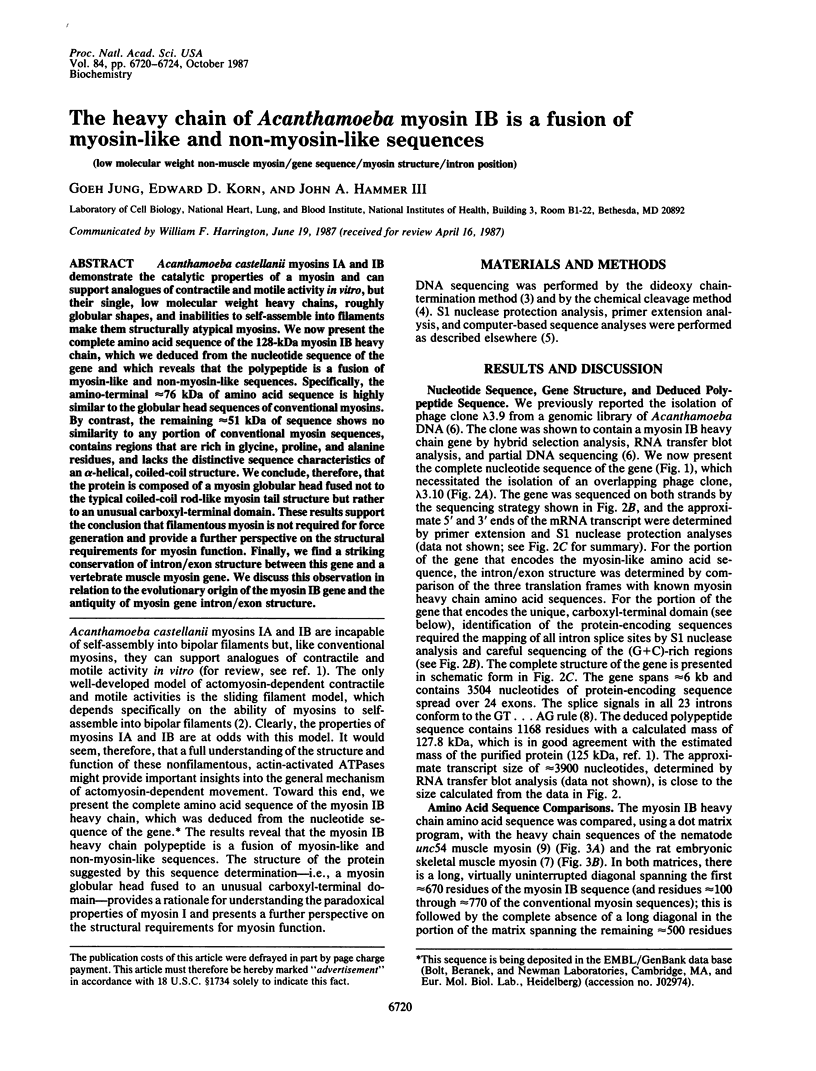
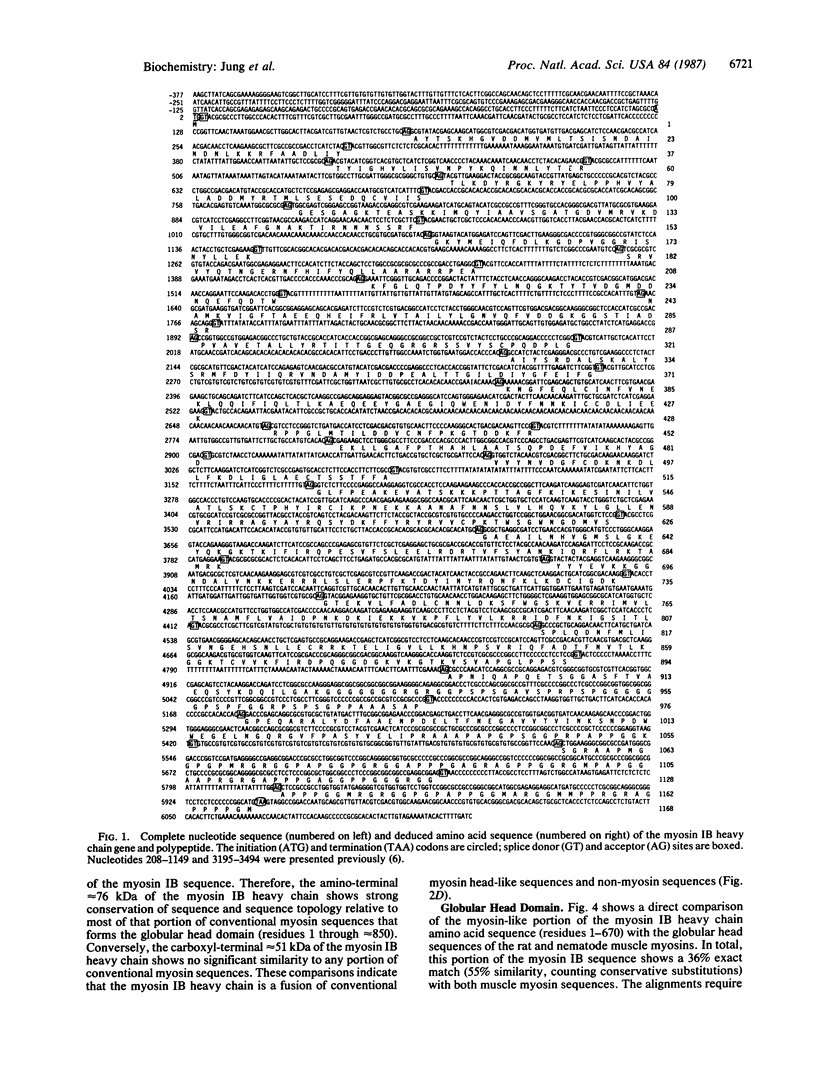
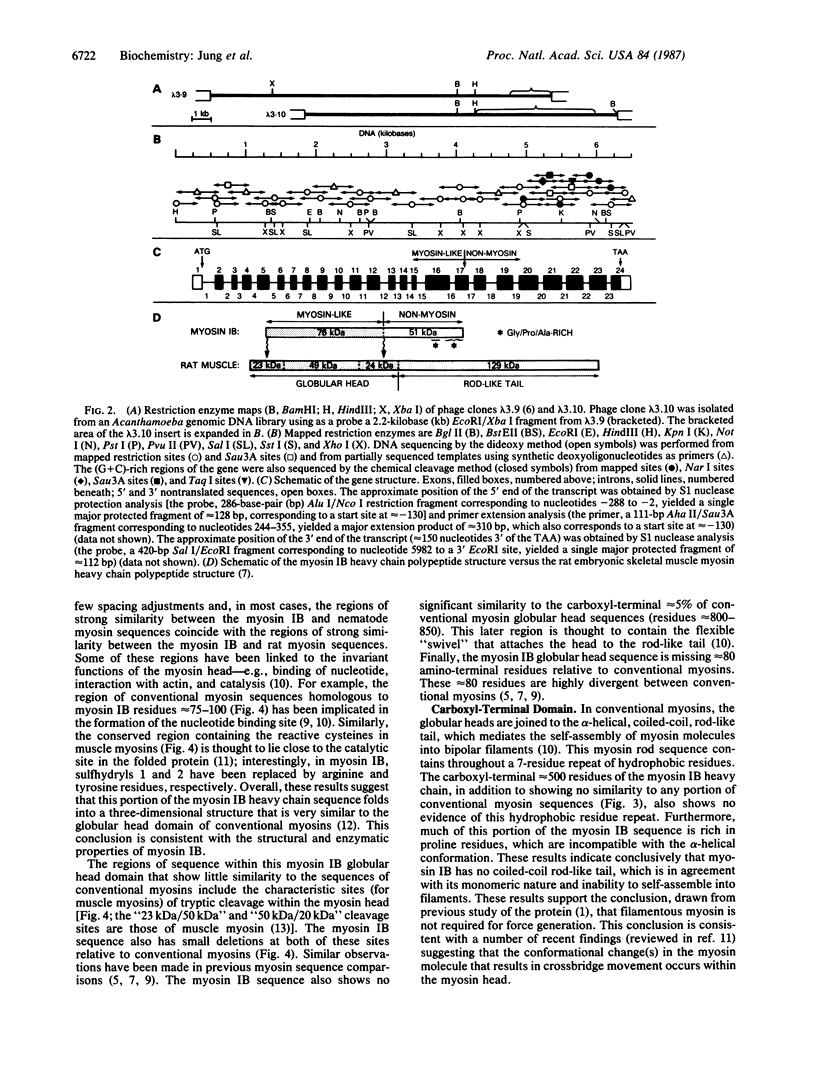
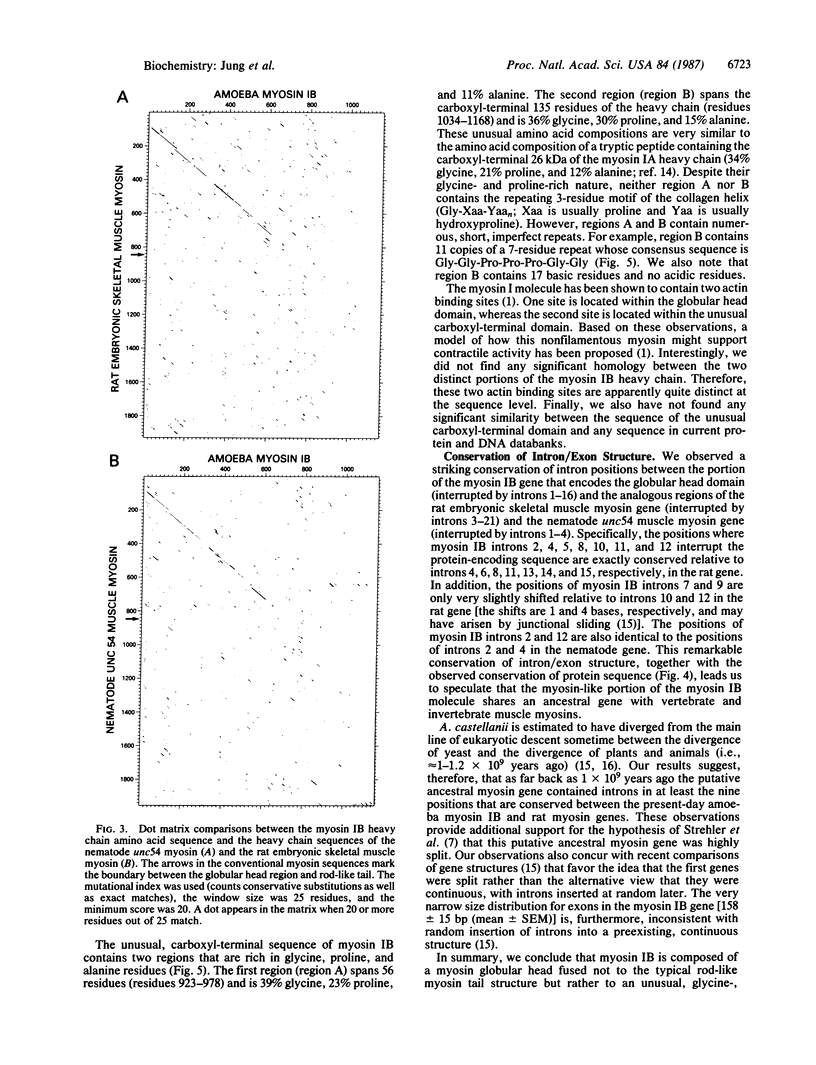
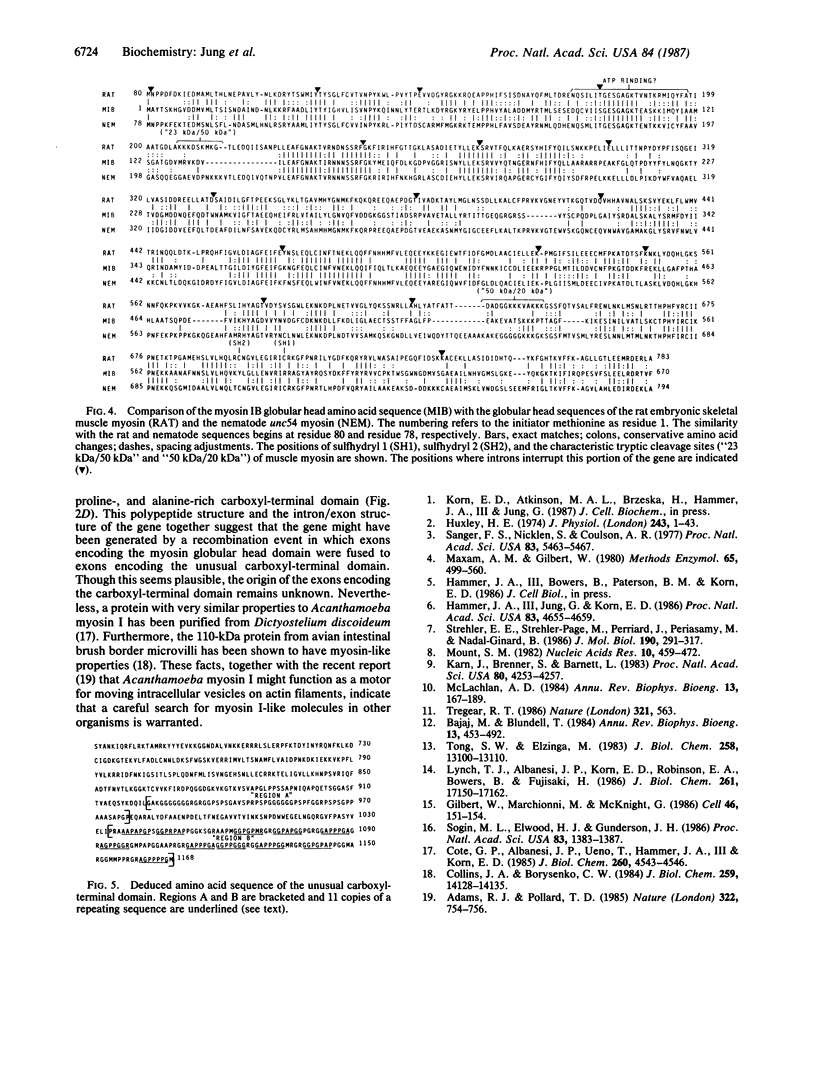
Selected References
These references are in PubMed. This may not be the complete list of references from this article.
- Adams R. J., Pollard T. D. Propulsion of organelles isolated from Acanthamoeba along actin filaments by myosin-I. Nature. 1986 Aug 21;322(6081):754–756. doi: 10.1038/322754a0. [DOI] [PubMed] [Google Scholar]
- Bajaj M., Blundell T. Evolution and the tertiary structure of proteins. Annu Rev Biophys Bioeng. 1984;13:453–492. doi: 10.1146/annurev.bb.13.060184.002321. [DOI] [PubMed] [Google Scholar]
- Collins J. H., Borysenko C. W. The 110,000-dalton actin- and calmodulin-binding protein from intestinal brush border is a myosin-like ATPase. J Biol Chem. 1984 Nov 25;259(22):14128–14135. [PubMed] [Google Scholar]
- Côté G. P., Albanesi J. P., Ueno T., Hammer J. A., 3rd, Korn E. D. Purification from Dictyostelium discoideum of a low-molecular-weight myosin that resembles myosin I from Acanthamoeba castellanii. J Biol Chem. 1985 Apr 25;260(8):4543–4546. [PubMed] [Google Scholar]
- Gilbert W., Marchionni M., McKnight G. On the antiquity of introns. Cell. 1986 Jul 18;46(2):151–153. doi: 10.1016/0092-8674(86)90730-0. [DOI] [PubMed] [Google Scholar]
- Hammer J. A., 3rd, Jung G., Korn E. D. Genetic evidence that Acanthamoeba myosin I is a true myosin. Proc Natl Acad Sci U S A. 1986 Jul;83(13):4655–4659. doi: 10.1073/pnas.83.13.4655. [DOI] [PMC free article] [PubMed] [Google Scholar]
- Huxley A. F. Muscular contraction. J Physiol. 1974 Nov;243(1):1–43. [PMC free article] [PubMed] [Google Scholar]
- Karn J., Brenner S., Barnett L. Protein structural domains in the Caenorhabditis elegans unc-54 myosin heavy chain gene are not separated by introns. Proc Natl Acad Sci U S A. 1983 Jul;80(14):4253–4257. doi: 10.1073/pnas.80.14.4253. [DOI] [PMC free article] [PubMed] [Google Scholar]
- Lynch T. J., Albanesi J. P., Korn E. D., Robinson E. A., Bowers B., Fujisaki H. ATPase activities and actin-binding properties of subfragments of Acanthamoeba myosin IA. J Biol Chem. 1986 Dec 25;261(36):17156–17162. [PubMed] [Google Scholar]
- Maxam A. M., Gilbert W. Sequencing end-labeled DNA with base-specific chemical cleavages. Methods Enzymol. 1980;65(1):499–560. doi: 10.1016/s0076-6879(80)65059-9. [DOI] [PubMed] [Google Scholar]
- McLachlan A. D. Structural implications of the myosin amino acid sequence. Annu Rev Biophys Bioeng. 1984;13:167–189. doi: 10.1146/annurev.bb.13.060184.001123. [DOI] [PubMed] [Google Scholar]
- Mount S. M. A catalogue of splice junction sequences. Nucleic Acids Res. 1982 Jan 22;10(2):459–472. doi: 10.1093/nar/10.2.459. [DOI] [PMC free article] [PubMed] [Google Scholar]
- Sanger F., Nicklen S., Coulson A. R. DNA sequencing with chain-terminating inhibitors. Proc Natl Acad Sci U S A. 1977 Dec;74(12):5463–5467. doi: 10.1073/pnas.74.12.5463. [DOI] [PMC free article] [PubMed] [Google Scholar]
- Sogin M. L., Elwood H. J., Gunderson J. H. Evolutionary diversity of eukaryotic small-subunit rRNA genes. Proc Natl Acad Sci U S A. 1986 Mar;83(5):1383–1387. doi: 10.1073/pnas.83.5.1383. [DOI] [PMC free article] [PubMed] [Google Scholar]
- Strehler E. E., Strehler-Page M. A., Perriard J. C., Periasamy M., Nadal-Ginard B. Complete nucleotide and encoded amino acid sequence of a mammalian myosin heavy chain gene. Evidence against intron-dependent evolution of the rod. J Mol Biol. 1986 Aug 5;190(3):291–317. doi: 10.1016/0022-2836(86)90003-3. [DOI] [PubMed] [Google Scholar]
- Tong S. W., Elzinga M. The sequence of the NH2-terminal 204-residue fragment of the heavy chain of rabbit skeletal muscle myosin. J Biol Chem. 1983 Nov 10;258(21):13100–13110. [PubMed] [Google Scholar]
- Tregear R. T. Muscle contraction. Crossbridges, force and motion. Nature. 1986 Jun 5;321(6070):563–563. doi: 10.1038/321563a0. [DOI] [PubMed] [Google Scholar]


